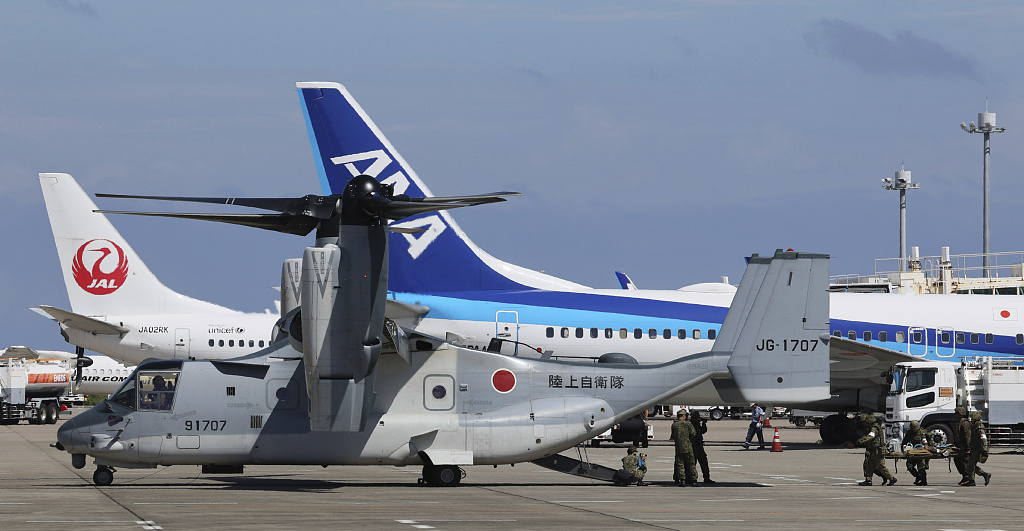
Osprey transport aircraft of the Japan Self-Defense Forces. (File photo)
By Yue Linwei and Guo Yuandan
Japan has recently held several military exercises and trainings in its homeland and surrounding areas. Reports from Western media including Japanese and US media all mentioned that the target of those exercises is China. Among them, the annual joint military exercise near the Japanese coastline hosted by Japan, the US, Australia, and Canada invited the Philippine Navy to participate and observe for the first time. So far, Japan has participated in four military exercises in November. Military experts said that such frequent military exercises have exacerbated the instability in the region and are obviously not in the interest of regional countries.
Japan's Kyodo News reported on November 13 that a disaster prevention training sponsored by the Yonaguni Government was held on November 12 on Yonaguni Island of Okinawa Prefecture, the western most part of the country. The US media absurdly said that the training was not only designed to respond to tsunamis caused by earthquakes, but also applied to the so-called "attempt by China to take control of nearby Taiwan". However, Kyodo News reported that on the day of the training, some residents held up pieces of paper on the beach with words such as "Do not prepare for war" .
If the above-mentioned training was under the banner of "disaster relief", then the following exercises were purely for military purposes. A joint military exercise between the Japan Maritime Self-Defense Force (JMSDF), the US Navy, the Australian Navy and Air Force, and the Canadian Navy and Air Force was held around Japan from November 10 to 20. This joint exercise is known as the largest joint military exercise in the history of the JMSDF, with about 30 ships and more than 40 aircrafts involved. In addition, senior Philippine Navy officials also participated in the exercises as observers. Japan's Fuji TV commented that this exercise was aimed at China and the Democratic People's Republic of Korea (DPRK). In addition to multilateral exercises, Japan and the US also launched a large-scale exercise, involving approximately 30,000 troops from Japan Ground Self-Defense Force (JGSDF), JMSDF, and Japan Air Self-Defense Force(JASDF) and approximately 10,000 US military personnel in various places across Japan, including Yonaguni Island, Amami Oshima Island and other areas, from November 10 to 20. Civilian airports that are not usually used in military drills are also involved for fighter jets takeoff and landing training.
In addition, the launch ceremony of the KAMANDAG 7 joint exercise among the US, the Philippines, Japan and South Korea was held on November 9, and the JGSDF participated in the exercise for the first time. The exercise will run until November 20 with more than 2,700 officers and soldiers from the four countries. The KAMANDAG 7 exercise was first held in 2017. This year is the seventh such exercise. Japan and South Korea participated in the exercise as observers in 2022.
Military expert Song Zhongping said that these military exercises participated by Japan, whether unilateral, bilateral, or multilateral, delivered the same message from the exercise location and subject settings: targeting China. "On the surface, it looks like Japan or the Philippines are leading the exercise, but in essence, it is the US that is creating the so-called 'Indo-Pacific Strategy' to allow more allies to help itcontain and confront China. The US hopes that the alliance circle in Asia will be as big as possible, and even become the 'NATO' of the 'Indo-Pacific'," said Song.
Japan has participated in at least four military exercises and trainings in less than half a month. In this regard, Song believes that if there are more exercises in a region, then the situation in the region is unstable, and provocations and even gunfire incidents in the region are more likely to occur. "But countries such as Japan and the Philippines also need to understand that when they create trouble for China, they are also creating trouble for themselves. Once the Asia-Pacific region also falls into a war, the economies of almost all countries in the region will be affected, and that is not in the interest of regional countries," said Song.
Editor's note: Originally published on huanqiu.com, this article is translated from Chinese into English and edited by the China Military Online. The information and opinions in this article do not necessarily reflect the views of eng.chinamil.com.cn.













